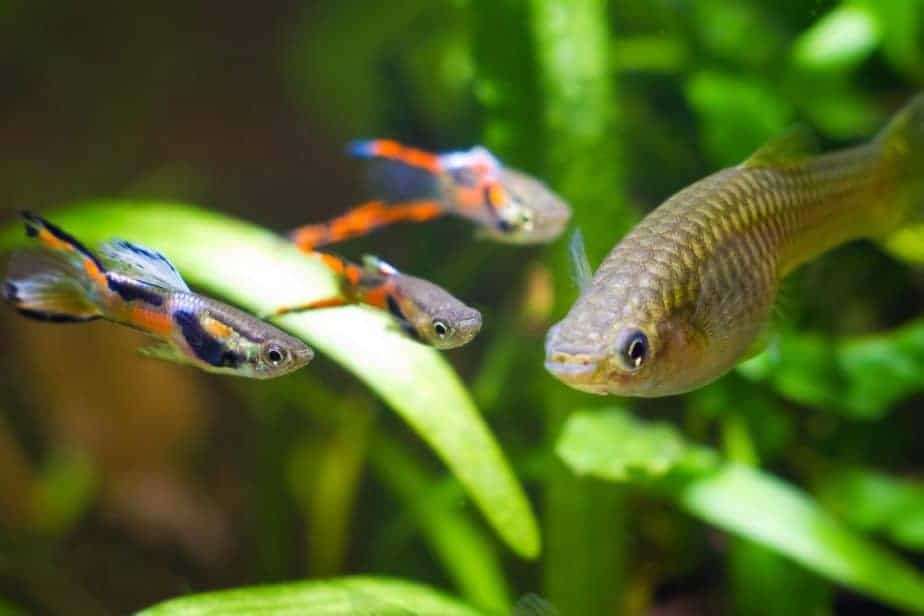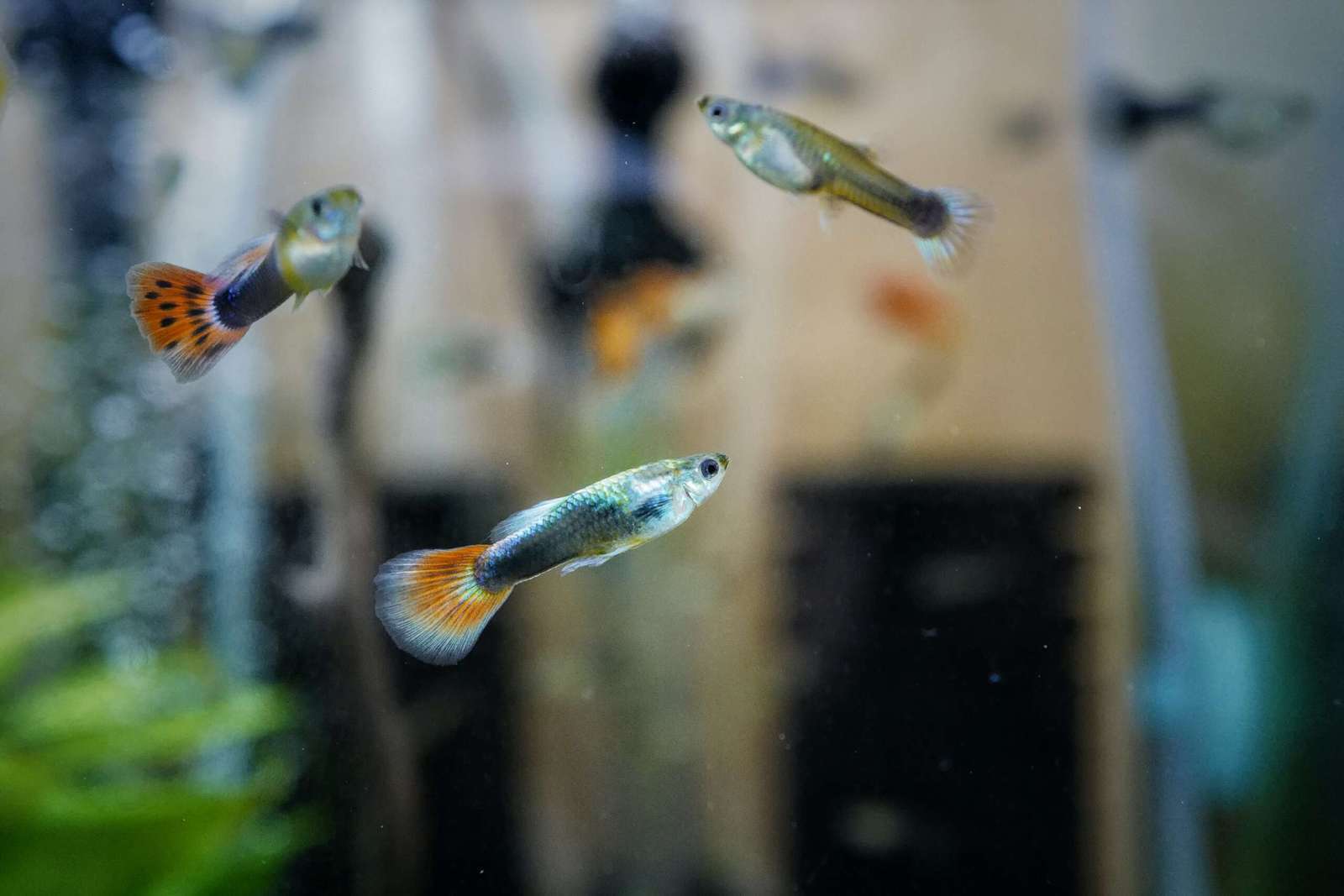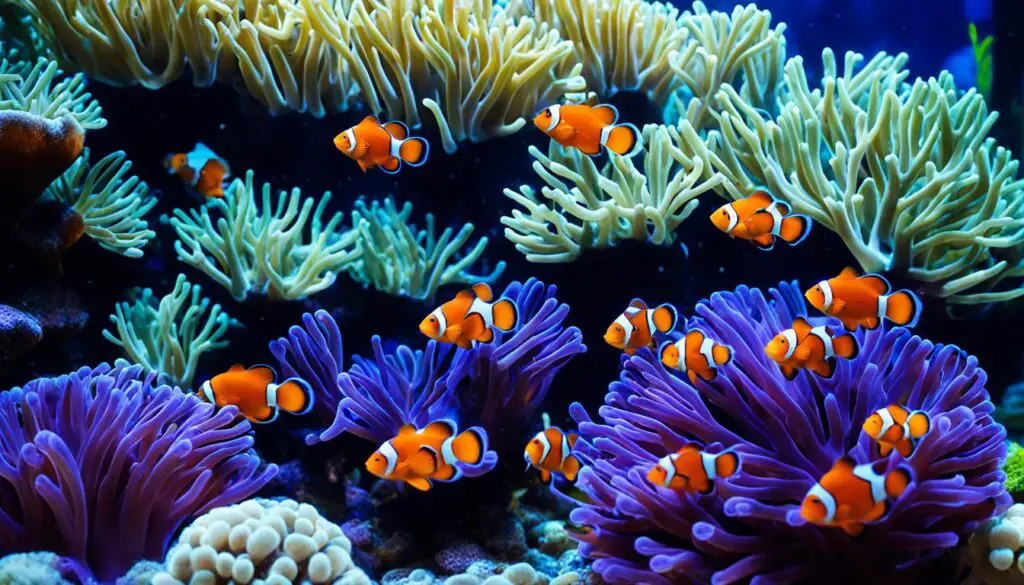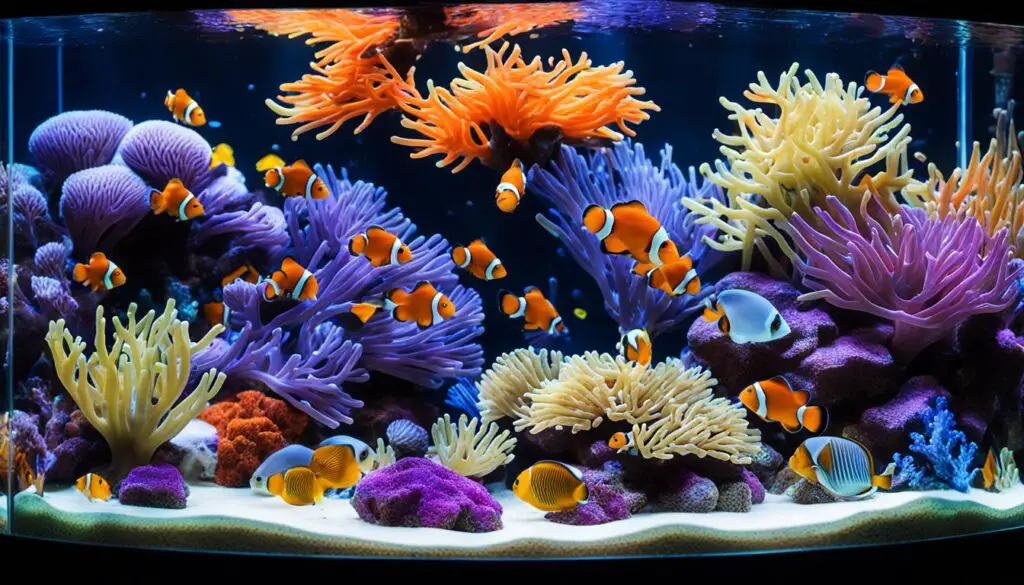How Many Guppies Should Be Kept Together

Introduction
How Many Guppies Should Be Kept Together: Guppies grow those colorful and charismatic freshwater fish, have captured the hearts of aquarists for generations. Their vibrant hues and lively personalities make them a popular choice for aquarium enthusiasts.
Guppies are a social species, and their sociable nature makes them thrive in groups. First and foremost, the size of your aquarium plays a crucial role. A larger tank can accommodate more guppies comfortably. Overcrowding can lead to stress, disease, and aggressive behavior, so determining the right stocking density is essential.
The gender ratio is another crucial factor. Male guppies are often more colorful and visually striking, but they can also be territorial and aggressive towards each other. To maintain peace and harmony, careful consideration of the male-to-female ratio is essential.
Water quality, filtration, and maintenance routines also influence the number of guppies your tank can support. Neglecting these factors can lead to disastrous consequences.
In this comprehensive guide, we’ll explore these considerations and provide valuable insights into creating a thriving guppy community in your aquarium. Whether you’re a beginner or an experienced aquarist, understanding how many guppies to keep together is key to providing your fish with a safe, happy, and vibrant environment.

Do guppies need to live together?
Tankmates. Guppies usually swim in groups and will likely be happier in a tank with other guppies. There should be at least three guppies together, and if you’re mixing genders, at least 66% should be female. Don’t house guppies with any aggressive species.
Guppies are naturally social fish, and they tend to thrive when they live together in a community. They exhibit fascinating behaviors, such as playful chasing and colorful displays, when surrounded by their own kind. Guppies are known for their striking colors, and these are often more vibrant when they’re in the company of other guppies. The presence of tank mates can also reduce their stress levels, enhancing their overall well-being.
However, while guppies enjoy companionship, it’s crucial to strike a balance. Overcrowding can lead to territorial disputes, increased stress, and higher chances of disease transmission. Therefore, it’s essential to consider the size of the aquarium and the gender ratio when determining how many guppies should be kept together. A well-maintained and appropriately sized tank, with a mix of males and females, can ensure a peaceful and thriving guppy community.
Guppies don’t necessarily need to live together, but they certainly benefit from it. Creating a suitable environment that accommodates their social nature and maintaining a harmonious balance in the aquarium will result in happy and healthy guppies that display their dazzling colors and engaging behaviors, making them a joy to watch and a fascinating addition to your home aquarium.
How many guppies do you need to be happy?
In a natural setting, every male guppy needs at least 4-6 females, 3 being the minimum. Thus, to accommodate 1 male guppy with some females and have them thrive, you would need at least 10-15 gallons. In a similiar way, you can have three males and 12-15 females in a 30 gallon tank.
The happiness of guppies, like any living creatures, isn’t solely determined by the number of companions they have but rather by the overall quality of their environment. Guppies are naturally social fish, and they do exhibit more engaging behaviors and vibrancy when kept in groups. However, the concept of their happiness transcends mere numbers.
To ensure guppy happiness, several key factors come into play. Adequate space, water quality, and appropriate nutrition are critical. An overcrowded tank can lead to stress, aggression, and territorial disputes, which certainly won’t contribute to their happiness. Therefore, choosing an aquarium size that allows them to swim freely and providing clean water with suitable filtration are essential.
Their diet should be balanced and nutritionally adequate to promote health and vitality. A well-balanced diet enhances their colors and overall well-being, contributing to their contentment.
In essence, while keeping multiple guppies together can be beneficial due to their social nature, it’s the quality of care, a stress-free environment, and proper husbandry practices that truly determine their happiness. Ultimately, a happy guppy is one that enjoys a healthy, stress-free life in a well-maintained aquarium, whether it’s in the company of others or in a carefully tended solo tank.
Can male and female guppies live together?
They are social fish. In theory you could keep them separately, however, they can get depressed when alone. The ideal ratio is two female guppies to one male guppy. Male guppies can get territorial when it comes to mating, so keeping 2:1 makes it so they aren’t too aggressive with any of the others.
Male and female guppies can coexist in the same aquarium, and often, they do so quite harmoniously. In fact, maintaining a mix of both genders can be an attractive and rewarding aspect of guppy keeping, as it mimics their natural social structure. However, several considerations are essential to ensure a successful cohabitation.
First, it’s vital to maintain a balanced male-to-female ratio. Male guppies are known for their vibrant colors and intricate tails, but they can become overly aggressive in the presence of too few females. A general guideline is to have at least two to three females for every male to help distribute the male’s attention and reduce aggression.
Secondly, guppies are prolific breeders, and without proper measures to control their reproduction, a small group of males and females can quickly lead to an overcrowded tank. If you’re not interested in breeding, you should either separate males and females or introduce some guppy-friendly fish that can help control the population.
Finally, it’s crucial to provide ample hiding places in the aquarium to allow females to take refuge when they need a break from the persistent advances of males.
Male and female guppies can indeed live together, but maintaining a proper gender balance, monitoring breeding, and providing hiding spots are vital for a successful and harmonious coexistence. When done right, keeping both genders together can provide an enjoyable and dynamic display of guppy behavior and natural social interactions in your aquarium.
How much space do 2 guppies need?
The minimum should be 5 gallons. Two guppies wouldn’t be ideal since they are schooling fish. You need to get three or more.
For two guppies, the minimum tank size you should consider is around 10 gallons (approximately 38 liters). This size allows for a sufficient amount of swimming space, as well as the ability to maintain stable water conditions. It’s crucial to remember that guppies are small but active fish that need space to swim and explore, and they produce waste that can accumulate in a smaller tank, leading to water quality issues.
In a 10-gallon tank, you can also incorporate appropriate decorations, plants, and hiding spots for the guppies. These elements are not only aesthetically pleasing but also serve as enrichment for the fish and can help reduce stress. Guppies are social creatures and tend to thrive when they have some companionship.
Keep in mind that larger tanks provide even more space for guppies to move around, and they are often easier to maintain in terms of water quality. If you plan to keep more than two guppies or intend to include other fish species in the same tank, a larger aquarium will be necessary to accommodate the increased bio-load and minimize the risk of overcrowding.
While two guppies can technically fit in a 10-gallon tank, providing them with a bit more space in a slightly larger tank is generally a better choice to ensure their health, happiness, and overall well-being.
How many times can a guppy give birth?
Guppies typically reproduce about every 30 days and give birth to litters approximately 20 times throughout their lives. The researchers found that as female guppies aged, they began to skip litters or even stop reproducing for extended periods of time, effectively ceasing to reproduce after a certain age.
Guppies are prolific livebearers, and they can give birth multiple times throughout their lives. A female guppy typically becomes sexually mature at around 2 to 3 months of age, at which point she can start reproducing. Once they reach maturity, female guppies can give birth every 4-6 weeks, and each birthing event can yield anywhere from 20 to 100 fry (baby guppies) depending on various factors such as the female’s age, health, and environmental conditions.
It’s worth noting that guppies are capable of storing sperm from a single mating for several months, so even if you have only one male guppy in your tank, females can continue to give birth without the need for repeated mating. This stored sperm allows females to have multiple broods from a single encounter with a male.
While guppies’ prolific breeding nature can be fascinating, it’s essential to plan for their rapid reproduction if you don’t want your tank to become overcrowded. Having adequate hiding places for fry and separating males from females can help control the population. If you want to manage the fry more effectively, you can also consider a separate breeding tank to raise them until they are old enough to be integrated into the main tank or given away.
Can I keep a single guppy, or do they need to be in groups?
While guppies are social and thrive in the company of their kind, they can also be kept individually. However, there are important considerations. Guppies are naturally gregarious, and they benefit from interaction and companionship. In a group, they engage in playful behaviors and exhibit their vibrant colors more prominently.
If you choose to keep a single guppy, it’s crucial to compensate for the absence of companionship with stimulating tank decor and regular interaction with you. Provide hiding spots, plants, and even a mirror for occasional stimulation. Also, allocate time for observing and interacting with your solitary guppy to alleviate potential loneliness.
Be attentive to their behavior. If the guppy shows signs of distress, like listlessness or lack of appetite, it may indicate a need for social interaction. In such cases, consider introducing more guppies or compatible tankmates.
Ultimately, while guppies can adapt to solitary living, they tend to thrive in the company of their kind. If keeping a single guppy, invest in creating an enriching environment and monitor their behavior closely to ensure their well-being and mental stimulation.
How do I determine the right number of guppies for my tank size?
Determining the appropriate number of guppies for your tank size involves considering factors like tank capacity, filtration, and the fish’s comfort. First, assess the volume of your tank in gallons or liters. As a general guideline, allocate about 1 gallon (3.8 liters) of water per inch of adult guppy, but keep in mind that guppies are small, typically growing to about 2 inches.
Next, consider the filtration system. Adequate filtration is crucial to maintain water quality, especially in a community tank. A more substantial population of guppies means a higher bioload, which necessitates a more robust filtration system.
Consider the presence of other fish species. Each species has its own space requirements and social dynamics. Factor in the tankmates’ needs when calculating the total fish population.
Additionally, observe the behavior and activity level of your guppies. If they appear stressed, show signs of overcrowding (like aggressive behavior or reduced swimming space), or if water parameters deteriorate despite regular maintenance, it might be an indication that there are too many fish in the tank.
A well-balanced approach involves considering the tank’s volume, filtration capacity, compatibility with other fish, and the behavior of the guppies themselves. Regular monitoring and adjustment ensure a healthy and harmonious aquatic environment for your guppies.
Can guppies be kept with other fish species in a community tank?
Yes, guppies can generally be kept with other fish species in a community tank. They are known for their peaceful and social nature, making them compatible with a wide variety of tankmates. However, there are a few considerations to keep in mind.
Firstly, it’s essential to choose tankmates that have similar water parameter requirements. Guppies thrive in slightly alkaline water with a pH level between 6.8 and 7.8. Therefore, it’s best to select fish that share these preferences to ensure the overall well-being of your aquatic community.
Secondly, consider the size and temperament of potential tankmates. Since guppies are relatively small and non-aggressive, they can be vulnerable to larger or more assertive species. Opt for fish that are of similar size and temperament to avoid any conflicts or potential harm to the guppies.
Lastly, provide ample hiding spots and plants in the tank to offer refuge for all inhabitants, especially the guppies. This helps reduce stress and promotes a harmonious coexistence.
With thoughtful planning and consideration, a community tank with guppies can be a thriving and visually captivating aquatic environment. Remember to monitor the tank regularly to ensure the well-being of all its inhabitants.

Conclusion
In the world of aquarium keeping, the question of how many guppies to keep together may seem simple at first glance, but it involves a delicate balance of various factors. As we’ve explored in this guide, maintaining a harmonious and healthy guppy community relies on careful consideration of tank size, gender ratios, and water quality.
For guppies, community living is the key to their happiness and well-being. They are social creatures that thrive when surrounded by their peers, yet overcrowding can lead to stress and health issues. Thus, it’s crucial to provide an adequately sized aquarium, ensuring that each guppy has enough space to swim freely and establish territories without excessive competition.
When it comes to gender ratios, a well-balanced mix of males and females is essential. Males are often more visually striking, but too many in a group can lead to aggression and dominance disputes. A reasonable male-to-female ratio can maintain a peaceful environment and reduce stress among your guppies.
Additionally, water quality and regular maintenance play a significant role in the overall health of your guppy community. Proper filtration, water changes, and monitoring of parameters like pH and temperature are vital for their well-being.
Ultimately, there’s no one-size-fits-all answer to the question of how many guppies to keep together, as every aquarium is unique. By understanding and applying the principles discussed in this guide, you’ll be better equipped to create a thriving and colorful guppy community that brings joy and beauty to your home. So, keep these factors in mind, and your guppies will reward you with their captivating presence and the joy they bring to your aquarium hobby.



